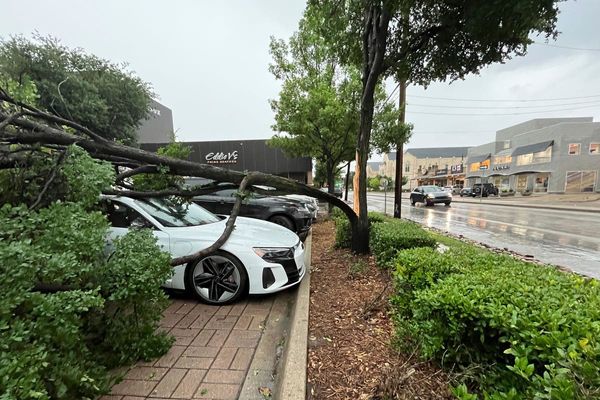
Fifteen years ago, when the original Nissan Leaf was introduced, it seemed like it would have been the surefire winner of the growing EV wars. That first-generation Leaf was the ultimate way for eco-minded drivers to express to the world that they were so much better than everyone else. It was the logical next step of the stereotypical Toyota Prius driver: they’d migrate to a Leaf, break up with gas entirely, and then the Leaf would dominate the future of transportation.
Yet, that didn’t happen. Tesla came on the scene and proved to everyone that the future of electric cars was way slicker, sleeker, and more technologically advanced.

That’s okay. For every Cybertruck owner extolling the virtues of Full Self-Driving as they take a baseball bat to its stainless steel body for TikTok follows, there is a growing gaggle of EV-curious buyers who simply want basic, functional transportation that isn’t too expensive. At a base price of $29,280, the Leaf is the cheapest new EV on sale in the United States, now that the Chevrolet Bolt twins are officially deceased. At least, for now. Their return is pending.
| 2024 Nissan Leaf | Quick Specs |
| Battery | 40 kilowatt-hour, lithium ion (S), 60 kilowatt-hour, lithium-ion (SV Plus) |
| Range | 149 miles (S), 212 miles (SV Plus) |
| Max DC Fast Charging Rate | 50 kW (S), 62.5 (SV Plus) |
| Output | 147 horsepower and 236 lb-ft of torque (S), 214 horsepower and 250 lb-ft of torque (SV Plus) |
| Base Price | $29,280 |
| As Tested Price | $38,210 |
But getting a new Leaf right now isn’t as cut-and-dried as it may sound. In 2018, Nissan introduced a heavily revised Leaf, with more power, more range, a new look, and more tech. But, was that enough? Now that it’s 2024, more EV competitors have metaphorically grown wings and learned how to even surpass Tesla. Nissan seems to be content to let the Leaf only plod around on land.

Yeah, it’s quicker than the first Leaf was and can go further, but it doesn’t have triple-digit DC fast charging speeds. Its battery is still air-cooled, instead of liquid-cooled like the overwhelming majority of EVs on the market. It’s not part of Nissan’s switch to Tesla’s NACS plug; hell, it’s still using CHAdeMO instead of CCS. Is the Nissan Leaf still relevant in 2024? To find out, I’d have to spend a week with one.
Driving Impressions
The Leaf’s 2018 redesign brought some mild platform revisions and a new trim that was good for over 200 miles of range. In 2023, the car was updated again, simplifying the model range to just two trims: S and SV Plus. The small battery, 40 kWh S trim, feeds a 147 horsepower motor. The topmost SV Plus model that I tested has a larger 214 horsepower motor, fed by a 62 kWh battery.

Suspension-wise, the Leaf isn’t all that complicated – it’s either refreshingly straightforward or annoyingly primitive depending on your perspective. It doesn’t have fancy low-profile motors mounted between the rear suspension, or a cell-to-body battery pack design meant to save weight and add body rigidity.
No, the Leaf is built like any given mid-2000s compact car. It’s a front motor, front-wheel drive car with a pretty routine front MacPherson strut front suspension, and a basic-but-robust semi-independent torsion beam rear axle. In the era of hyper-fast, super-advanced EVs, the Leaf is basic.
That’s okay though.
Like most EVs, horsepower doesn’t tell the full story of a vehicle’s performance. The Overton window has shifted, and now 215 horsepower may sound downright underpowered to some. That’s not fair though. We can’t forget about the Leaf’s 250 ft/lbs of torque—it's available in an instant, which makes it zip to 60 mph at a surprisingly quick rate.
Our friends at Motor Trend got one to hit 60 in as little as 6.7 seconds; that’s probably quicker than your favorite hot hatch you idolized back in high school. In the real world, the Leaf feels sufficiently swift, but I’d stop short of dubbing it a fast EV. However, mash the throttle to the floor on an empty road, and the Leaf will do its best impression of a rambunctious dog trying to run on a freshly oiled hardwood floor.

However, the ride and handling show the Leaf’s basic car construction. Some have called the Leaf fun to drive, and I’d agree on some level, but I don’t think the car’s slightly engaging character comes from any sort of suspension or steering goodness. The steering is okay – not much feel, but accurate with a surprisingly quick ratio.
The handling is about the same, accurate, but not particularly enticing; but because the Leaf is comparatively low-slung and car-shaped compared to most EVs on the market, by virtue it feels so much more maneuverable than any SUV-shaped competitor in a similar price range. Throw it into a corner, and it doesn’t do anything all that interesting.
The ride wasn’t all that great either. Busy, bumpy, and unsophisticated. To me, the Leaf drives as if it’s a toddler trying to walk on its tippy toes; it was disjointed, jittery, not all that composed, and fairly stiff without any strong handling chops that one would think to be inherent to a car with mediocre ride quality.
More importantly, it was a far cry from the original Leaf which had a smooth and soft ride. Some buyers might not mind the Leaf’s ride, but perhaps the older I get I have less patience for suspension setups that can’t do two things at once. I don’t think the Leaf needs to be a corner carver, but if it’s going to ride like this, then I should get something out of it, no?

On a positive note, the best part of the Nissan Leaf experience would be its one-pedal driving. Smooth, predictable, and uncomplicated, the e-Pedal is a friendly reminder that Nissan pioneered and perfected one-pedal driving on its first try.
Range, Battery Size, Observed Efficiency
Nissan sent me a 60 kWh Leaf SV plus. A keen-eyed EV enthusiast may notice that number is down from 62 kWh of the 2018-2022 car, but it’s not that big of a deal. Nissan says there were only slight battery chemistry alterations, and the 60 kWh label is reflective of its actual usable battery capacity. It’s good for 212 miles of range, slightly down from the 226 of the 2022 model. I’d wager that it’s probably because of those snazzy basket-weave-like rims Nissan’s fitted to all the top-trim SV plus models.

Not including charging losses, I averaged 3.2 miles per kWh, or around 107 MPGe if you’re more partial to that unit of measurement. I didn’t do a full flat-to-full EV range test, but given the average efficiency and usable battery capacity, the Leaf was on track to achieve 192 miles of range. Not bad.
Keep in mind the Leaf was driven in roughly an equal mix of freeway and city traffic. The press loan took place during early fall, which means cooler temperatures and the use of the electric heater. The 2024 Leaf does have a heat pump, but it may need some assistance from PTC heating to boost interior ambient temperatures.
Charging Experience
When the Leaf was updated for 2018, Nissan doggedly stuck with the old CHAdeMO DC fast charging port, even as it had become exceptionally clear that CCS was going to win out. Thus, the Leaf is locked out of so many DC fast charging stations – Electrify America, ChargePoint, and many other DC fast charging service providers have all announced they’re sunsetting support for the CHAdeMO charging port.
We’ve asked Nissan if it has plans to do a CHAdeMO to CCS adapter, and it said that it “cannot comment further on plans for CHAdeMO-equipped vehicles.” There is a third-party CHAdeMO to CCS adapter, but it’s very expensive. Also, the CHAdeMO association doesn’t think it’s a smart idea to use it at all in the first place.

Even if we ignore the charge port compatibility woes, the Leaf’s charging abilities appear lackluster compared to modern EVs which are only slightly more expensive. The Leaf lacks features like battery charging preconditioning or preheating. Heck, its battery is still air-cooled, not liquid-cooled like most of its EV competitors. On the AC charging front, there is no way to adjust the maximum amps the car will pull from a level 1 or level 2 charger. It does appear that there’s a hard limit in the car’s software to 12 amps and 32 amps respectively.
In practice, the Leaf’s charging ability felt mostly fine. Before my time with the Leaf, I had never used a CHAdeMO charge port, I’d argue that it’s ergonomically superior to CCS. No matter the charging station, the CHAdeMO port clicks in easily, and during the four DC fast charging events I had with the Leaf, it never had any compatibility issues interfacing with several brands of DC fast chargers.
During one charging event, I plugged into a DC fast charger at 17%. The Leaf reached its max 62.5 kW speed fairly quickly, held strong, and tapered down to a reasonably quick 35 kW when it passed 85%. A 20 to 80% charge in the Leaf took me about 35 minutes. That isn’t particularly fast, but likely fast enough for a price-conscious buyer.
The Leaf’s level 2 charging experience was similarly uneventful, although its 6.6 kW max onboard charger is a bit on the low side compared to the 9.6 - 14kW units found in newer EVs.
Interior
In the crossover-crazy era where seemingly every new nameplate (especially electric ones) is a high-riding SUV, the Leaf stands out by being distinctly car-shaped. Yet, that doesn’t seem to deter the car’s interior quality, or interior packaging. The interior is well finished albeit basic.
There are little to no soft-touch plastics, but the plastics themselves fit well and look nice. The window switches, door handles and even key fob are the same as any other Nissan, so a driver won’t need to take a Skillshare course to figure out how to work the Leaf. For EV hopefuls in search of a glitzy and flashy car that stokes the car design geek, the Leaf might be a deal breaker. For others, they might find the Leaf’s simplistic and easy-to-use interior refreshing. The hardest thing about the Leaf is its orb-shaped gear shift.

Thankfully, the Leaf is well-packaged. Legroom is solid for both rows of seats, even if numerically the rear seat is a bit tighter than the average compact car. In person, it doesn’t feel that way, because the seats are mounted somewhat high for a car that has no pretension of being a crossover.
As a whole, the Leaf is comfortable, the driving position avoids the feeling as if you’re sitting on top of the battery, unlike some EVs, where the seats are mounted uncomfortably close to the floor. I fit well comfortably in both rows of seats, but I also admit that I am only 5’9”. Taller drivers might be less enthralled with the Leaf.
Tech Features
The Leaf is about as advanced as a pre-paid budget flip phone. Once again, a buyer in search of a tech-laden car will be significantly disappointed by the Leaf. But, an EV hopeful in search of a back-to-basics driving experience, will like the Leaf. Hell, the Leaf’s gauge cluster is partially an analog dial. There’s a small configurable digital display, but otherwise, it’s pretty light on tricks and tips. The SV Plus model adds standard heated seats and Nissan’s suite of ADAS features (called Pro Pilot Assist) a suite of features that are mostly identical between trim levels.
Are Android Auto and Apple Carplay “tech features?” Because that’s all you’re gonna get, folks. And no, they aren’t wireless.
Infotainment & User Experience
Despite the low level of features, Nissan’s 8-inch infotainment screen is simple, snappy, and easy to use. It looks like the same unit used in its cheaper ICE cars, so it’s got buttons, knobs, and dials, that are all dead simple to use. There aren’t a lot of features in the infotainment screen itself, but there are some EV-specific functions like energy usage or charging station location via GPS.

The HVAC temperature and fan speed are controlled by a simple row of physical buttons below the main infotainment screen. It’s easy and reliable, but probably not all that compelling to a buyer who is looking for Nissan’s version of a Tesla Model 3. There’s a Nissan Leaf app, but it’s so basic, that I can’t imagine owners intentionally using it for much aside for pre-heating or pre-cooling the vehicle’s interior on an exceptionally hot or cold day.
Safety & ADAS
All Nissan Leafs come with Standard Nissan Safety Shield 360, which is NIssan-speak for a fleet of crash avoidance technology. All Leafs come with Automatic Emergency Braking with Pedestrian Detection, Rear Automatic Braking, Blind Spot Warning, Rear Cross Traffic Alert, Lane Departure Warning, and High Beam Assist.
The SV Plus adds Pro Pilot Assist, which is effectively sophisticated radar cruise control that can accelerate or stop in heavy traffic.
Pricing & Trims
The S, with the 40 kWh battery, 149-mile range, and less powerful motor stickers for $29,280 including the destination fee. The upgraded Leaf SV Plus is $37,135. Both cars are eligible for half of the IRA’s tax credit, effectively making the Leaf $25,530 and $33,385, respectively. The SV Plus trim is likely the best buy for a buyer in search of a 200-mile + EV – the extra power, heated seats, and extra range make the Leaf SV Plus the better buy of the two.

Verdict
I have to level with you all. When I first received the Leaf, I came in low-key expecting to hate the thing, but I didn’t at all. I found it mostly pleasant to use.
I appreciated its car form factor; it stands out in a world full of oversized, overpowered SUVs. But, so much about the car feels like it’s just an older product in dire need of a replacement, which it is. Even since the Leaf’s refresh in 2018, EVs can do so many more things, and Nissan hasn’t really implemented these updates here. The Ariya is a better example of what a modern Nissan EV can be, but it’s also much more expensive.
The Leaf’s real-world range, efficiency, performance, and driving dynamics are fine enough, but the price seems somewhat high for the level of equipment the car offers. It’s a stone’s throw from the Hyundai Ioniq 6, which is a better, bigger car that drives even further. If the Leaf SV Plus was in the mid-20 K range, and its S model was in the high teens, maybe it would be more compelling, but alas, it isn’t.
We can’t dismiss the elephant in the room, either: the Leaf’s CHAdeMO port makes it a non-starter for most EV charging stations. I know some buyers could be allured by the Leaf’s easy-to-use nature, but given how fast CHAdeMO stations are disappearing, there’s a real concern that Leaf owners could be left with a car that has been effectively outmoded and unable to use most of the growing DC fast charging network. As it is, the 2024 Nissan Leaf validates so many fears that anti-EV pundits have, that buyers will en masse be stuck with a paperweight that isn’t able to be used. I can’t even say they’re wrong on this one.

Still, I can’t help but feel that if Nissan fixed those problems for the Leaf’s next act, it could be a compelling offering again. A new Leaf that kept this vehicle’s car-shaped form factor and easy-to-use nature could be just what the market needs.
But that car ain’t this one.
Contact the author: kevin.williams@insideevs.com
Gallery: 2024 Nissan Leaf SV Plus














